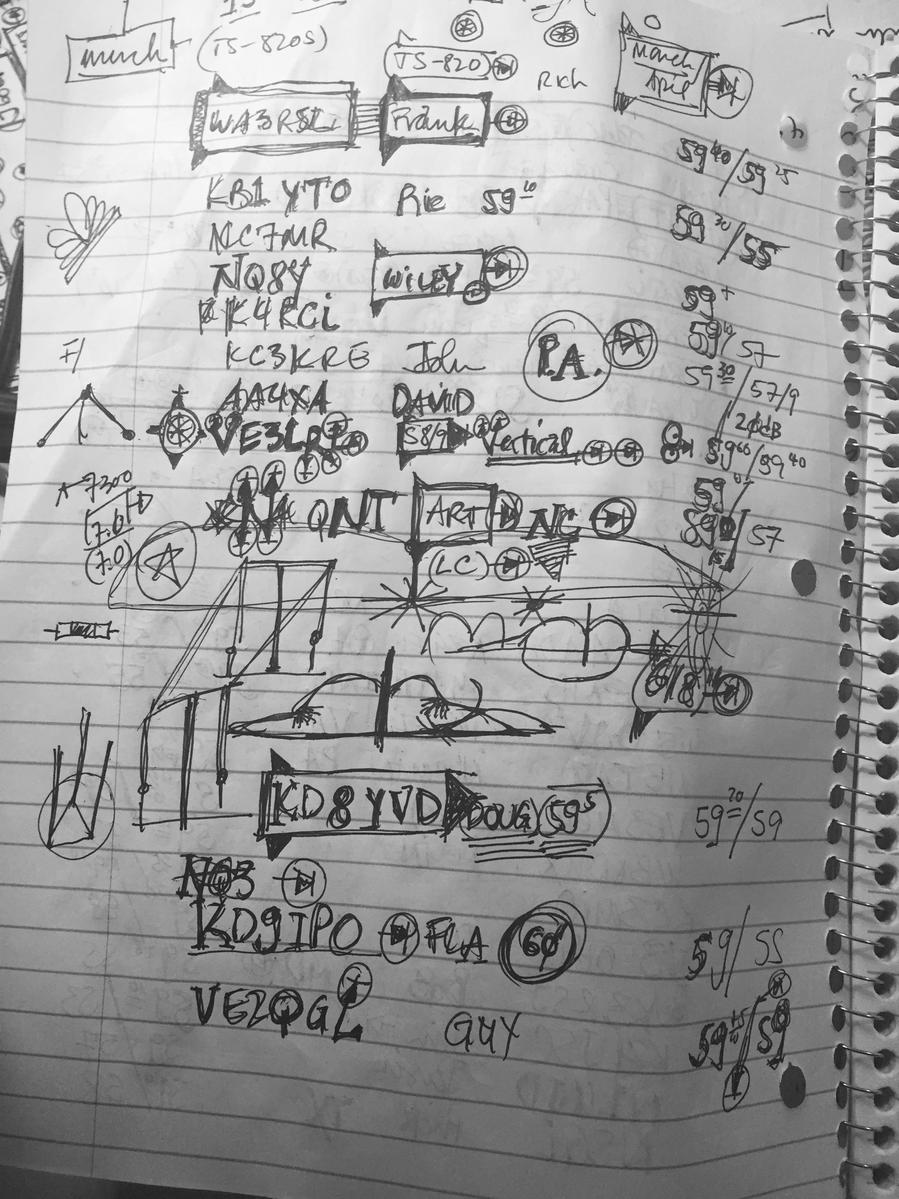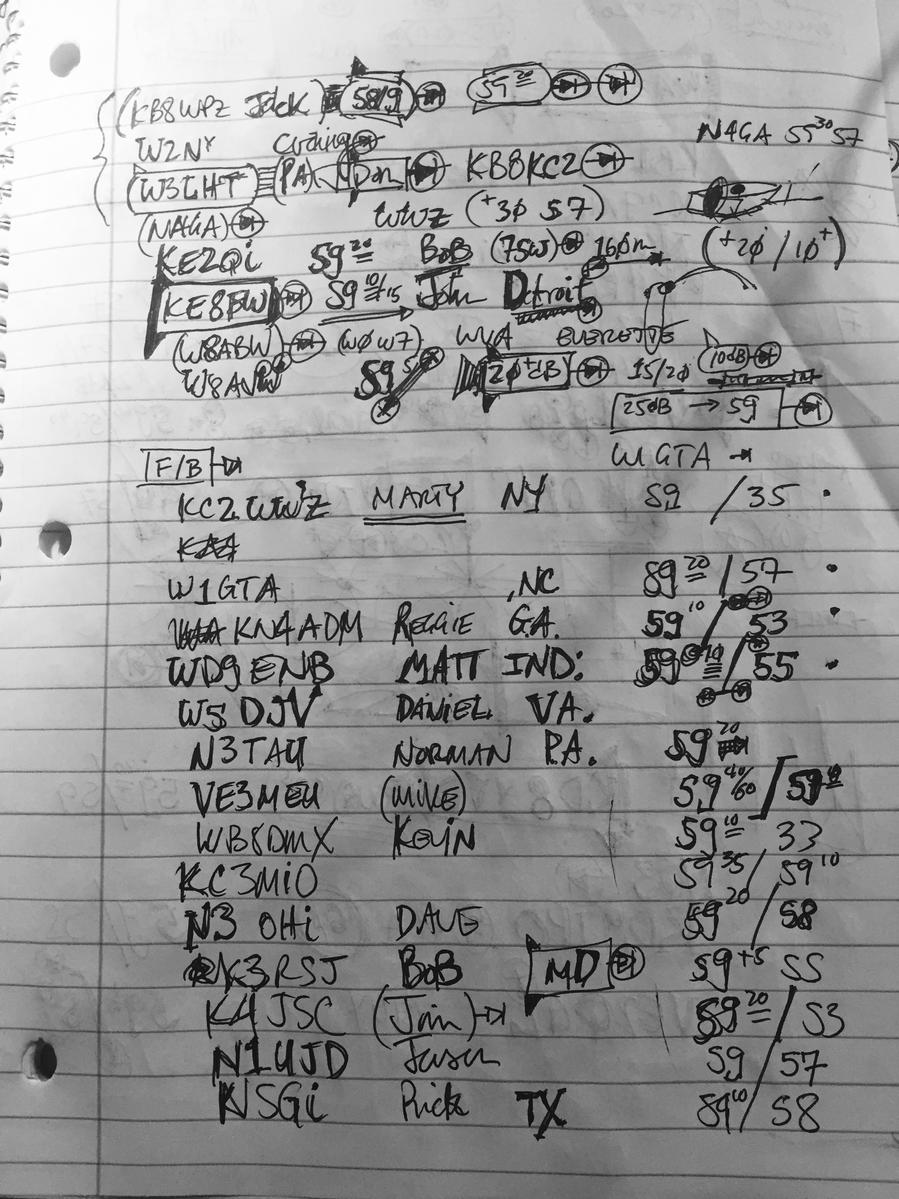Checking the F/B on 7.220 Mhz
Tonight we ran F/B checks on 7220 Mhz during which about 50 amateurs, who presumably follow events posted on this QRZ.com page, provided F/B reports. In addition, and quite to my delight, several hams who could not wait through my slow pile-up operating style opted to email me in their F/B impressions! Thank you, guys! Below we see the operating position at the height of taking F/B reception reports, as well as the desk notes this session produced during its three-hour duration.
 |
QRZ.com Readers Submit F/B Reception Reports
In Massive 3-Hour Pile-Up on 7.220 Mhz.
***
|
 I added the 6" segment of coax to the phasing line to "walk" its maximum F/B down from about 7280. However, and as detailed in previous updates, this locked the phased verticals into one another producing prodigious F/B over a wide swath of frequencies, from the CW portion of the 40 Meter band all the way up above 7.2 Mhz. Thus I selected 7.220 Mhz to check the F/B to see how the verticals were performing so far above the design frequency of 7.1 Mhz. The results were fascinating, the highlight perhaps being Canadian maritime stations reporting the exact opposite results from those submitted from amateurs situated to the Southwest. Of course, this is what is supposed to happen, according to theory. But it is always exhilerating to see theory confirmed empirically. After the F/B ratio reports were written down in the "scientific notebook" maintained in the shack, I looked up each station on QRZ.com and recorded their azimuth bearings in for inclusion in the table submitted below for your hopefully enjoyable review. Thanks everybody!
I added the 6" segment of coax to the phasing line to "walk" its maximum F/B down from about 7280. However, and as detailed in previous updates, this locked the phased verticals into one another producing prodigious F/B over a wide swath of frequencies, from the CW portion of the 40 Meter band all the way up above 7.2 Mhz. Thus I selected 7.220 Mhz to check the F/B to see how the verticals were performing so far above the design frequency of 7.1 Mhz. The results were fascinating, the highlight perhaps being Canadian maritime stations reporting the exact opposite results from those submitted from amateurs situated to the Southwest. Of course, this is what is supposed to happen, according to theory. But it is always exhilerating to see theory confirmed empirically. After the F/B ratio reports were written down in the "scientific notebook" maintained in the shack, I looked up each station on QRZ.com and recorded their azimuth bearings in for inclusion in the table submitted below for your hopefully enjoyable review. Thanks everybody! |
| F/B Table |

 What we're looking for is the following. Since the phased verticals are sited 60˚ Northeast and 240˚ Southwest, we compare the F/B reports to their compass bearings. The F/B ratio reports from stations situated on or near either of these two bearings, 60˚ and 240˚, are looking directly into the then away from the forward lobe. Their's will be front-to-back observatiuons. Reports received from stations situated 90˚ off these bearings, e.g. 150˚ and 330˚, will be situated perpendicular to the array's F/B pattern, and expected to see no difference at all. From these stations we should see smaller F/B ratio reports. Stations situated about 45˚ +/- the main lobe bearings (60˚, 240˚) might be seen providing the largest F/B reports since they will be seeing the forward lobe and then one of the array's rear-quarter nulls produced to create the small nub off the rear-end due to non-optimum tuning of the F/B. Hence we look to see if stations +/- 45˚ (or so) off-axis from the dead rear-end reporting higher F/B ratios. All of this is, of course, quite subjective. But it is fun to do, and represents the way original spark gap poineers shared with others, through wireless means, the results of their individual tinkerings with the ether. And that is exactly what we are doing here.
What we're looking for is the following. Since the phased verticals are sited 60˚ Northeast and 240˚ Southwest, we compare the F/B reports to their compass bearings. The F/B ratio reports from stations situated on or near either of these two bearings, 60˚ and 240˚, are looking directly into the then away from the forward lobe. Their's will be front-to-back observatiuons. Reports received from stations situated 90˚ off these bearings, e.g. 150˚ and 330˚, will be situated perpendicular to the array's F/B pattern, and expected to see no difference at all. From these stations we should see smaller F/B ratio reports. Stations situated about 45˚ +/- the main lobe bearings (60˚, 240˚) might be seen providing the largest F/B reports since they will be seeing the forward lobe and then one of the array's rear-quarter nulls produced to create the small nub off the rear-end due to non-optimum tuning of the F/B. Hence we look to see if stations +/- 45˚ (or so) off-axis from the dead rear-end reporting higher F/B ratios. All of this is, of course, quite subjective. But it is fun to do, and represents the way original spark gap poineers shared with others, through wireless means, the results of their individual tinkerings with the ether. And that is exactly what we are doing here. 
No comments:
Post a Comment